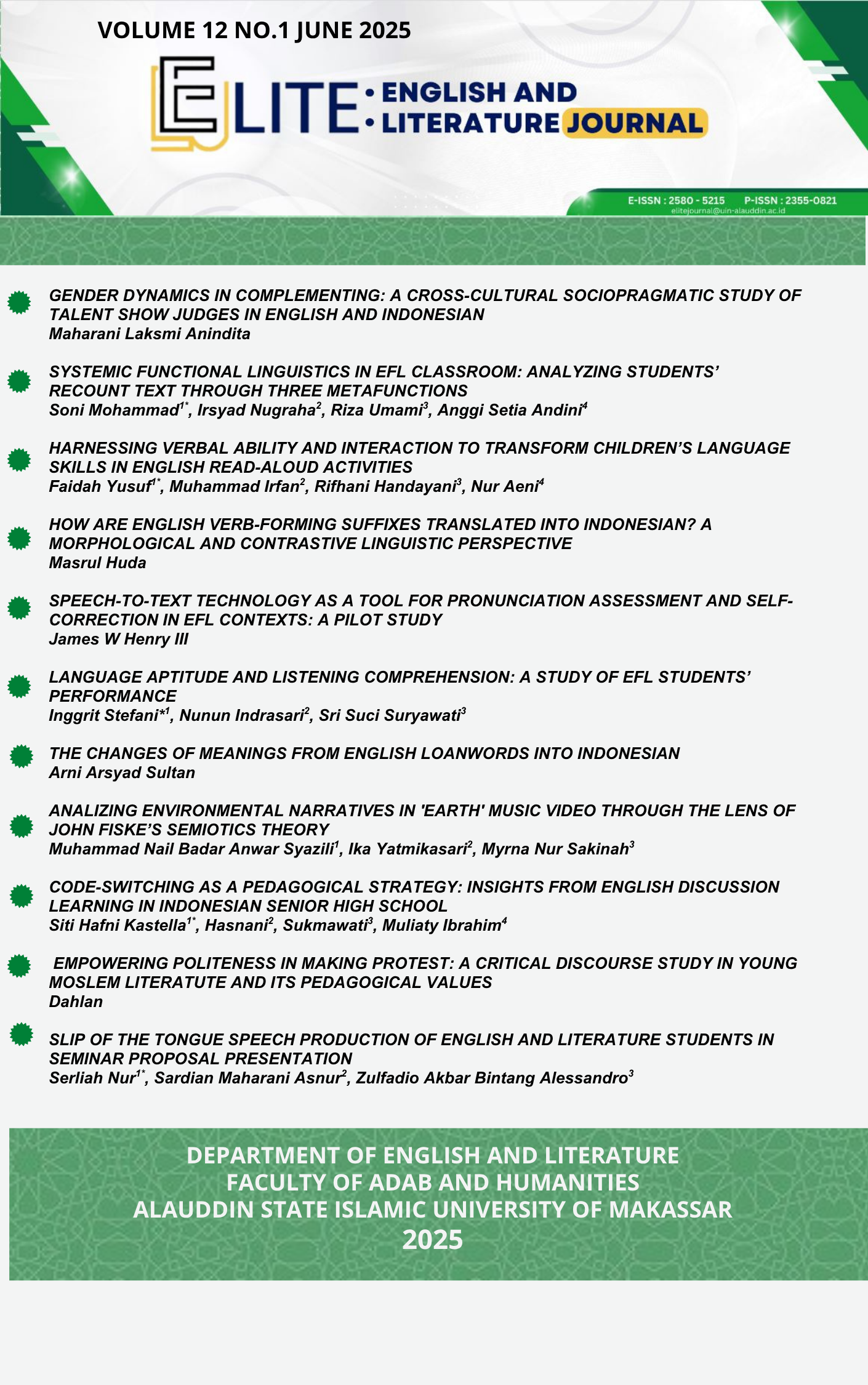EMPOWERING POLITENESS IN MAKING PROTEST: A CRITICAL DISCOURSE STUDY IN YOUNG MOSLEM LITERATUTE AND ITS PEDAGOGICAL VALUES
Keywords:
empowering, politeness protest, Moslem young literatureAbstract
This study explores the concept of empowering politeness in protest discourse within young Muslim literature, employing a critical discourse analysis (CDA) framework. It examines how politeness strategies are used not to soften resistance, but to assert agency, uphold moral authority, and engage in constructive dissent. The study employs a qualitative approach, using Critical Discourse Analysis (CDA) to examine a corpus of texts written by young Muslim authors. These texts cover two novel narratives, reflecting a Moslem sociocultural context. Through close textual analysis, the results of the study showcase how the authors empower protest not as an act of aggression, but as a principled stance that aligns with religious and cultural norms. The results of the study also show how linguistic choices and strategies reflect etiquette (adab) and wisdom (Hikmah) values of respect, empathy, and ethical engagement, even within confrontational contexts. The research results further highlight the pedagogical potential of such texts in educational settings. They offer rich material for teaching critical literacy, intercultural communication, and ethical reasoning. Through the lens of empowering politeness, students can learn to articulate dissent responsibly. This study advocates for the integration of diverse voices and values in both literary appreciation and language education.
Downloads
References
Azzah, A., & Mujiyanto, J. (2023). The Implementation of Politeness Strategies in Showing Disagreement Among the Communicative Members. English Education Journal, 13(1), 118–127.
Brown, P., & Levinson, S. C. . (1987). Politeness: Some universals in language usage. Cambridge University Press.
Builqin, & Gursel, G. (2020). Critical Discourse Analysis: An effective Tool for Critical Education informed By Freirean Dialogue. Educational Police Analysis and Strategic Research.
Clifton, & Jennifer. (2017). Argument as Dialogue Across Difference: Engage Youth in Public Literacy. Routledge.
Ellis, D. (2010). Refuge and Migrant Narrative in No Safe Place. Canada Ground wood Books.
Fairclough, N. (1989). Language and Power. Longman.
Fairclough, N. (1992). Discourse and Social Change. Cambridge.
Fairclough, N. (1995). Critical Discourse Analysis: The critical study of language. Longman.
Fecho, B., & Clifton, J. (2016). Reading as Resistance: Youth Literature and the Teaching of Social Justice (Language,). Amazon Com.
Giroux, H. A. (2005). Border Crossings: Cultural Workers and the Politics of Education. Routledge.
Gregorius, & Christina. (2021). Journey into Hell where Migrants froze to death. Trendz in Organized Crime.
Hanifah, A., Kamila, A., Nisa, A., Putri, Y., & Wahyunengsih, W. (2024). Getting Around the Problems Politeness of Globalization in Social Studies Learning and Character Building. Jurnal Pendidikan Tambusai, 8(2), 30305–30311.
Iswahyudi, Safal, U., & Azizah, D. (2021). Deradicalization of Religious Understanding Through the NU Online and Suara Muhammadiyah Website in the Perspective of Critical Discourse Analysis. Dialogia: Jurnal Studi Islam Dan Sosial. https://jurnal.iainponorogo.ac.id/index.php/dialogia/article/view/2782
Jessica Naidu, et al. (2023). A critical lens on Health: Key Principles on Critical discourse Analysis and Its benefits to Anti Racism. Societies, MDPI, Vol 13 (2).
Locher, M. (2004). Power and Politeness in Action : Disagreement in Oral Communication. New York Mouton.
Murni, M. (2020). The Islamic ideology of Indonesian linguistic politeness. Aceh International Journal of Social Science, 1(1), 28–34. https://doi.org/https://doi.org/10.53627/aijss.v1i1.1362
Norton, B. (2000). Identity and Language Learning: Gender, Ethnicity and Educational Change. Longman.
Norton, B., & Toohey, K. (2004). Critical pedagogies and language learning. Cambridge University Press.
Putri, R. D. (2021). Being young female Muslims in Islamic fictions: Moral anxiety, faith primacy and ideal image discourse. Simulacra: Journal of Sociology, 4(1), 97–111. https://doi.org/https://doi.org/10.21107/simulacra.v4i1.8715
S.K., A. (2019). Love from A to Z. Salaam Reads.
Tahmasbi, M. K. (2020). A Critical Discourse Analysis of the Representation of Hijab Protests in Iran: A Case Study of the Girls of Revolution Street. Academia.Edu. https://www.academia.edu/42079402%0A%0A
Weninger, C. (2007). Am I being polite or politically correct? A critical discourse analysis of politeness in protest narratives. Journal of Language and Politics, 6(3), 407–423. https://doi.org/https://doi.org/10.1075/jlp.6.3.05wen
Wolk, S. (2009). Reading for a better world: Teaching for social responsibility with young adult literature. Journal of Adolescent & Adult Literacy, 52(8), 664–673. https://doi.org/https://doi.org/10.1598/JAAL.52.8.2
Yousafzai, M. (2018). We Are Displaced: My Journey and Stories from Refugee Girls Around the World. Little, Brown Books for Young Readers.
Downloads
Published
How to Cite
Issue
Section
License
Copyright (c) 2025 Dahlan Dahlan

This work is licensed under a Creative Commons Attribution-NonCommercial-ShareAlike 4.0 International License.
Once an article was published in the journal, the author(s) are:
granted to the journal right licensed under Creative Commons License Attribution that allows others to share the work with an acknowledgement of the work's authorship.
permitted to publish their work online in third parties as it can lead wider dissemination of the work.
continue to be the copyright owner and allow the journal to publish the article with the CC BY-NC-SA 4.0 license
receiving a DOI (Digital Object Identifier) of the work.













